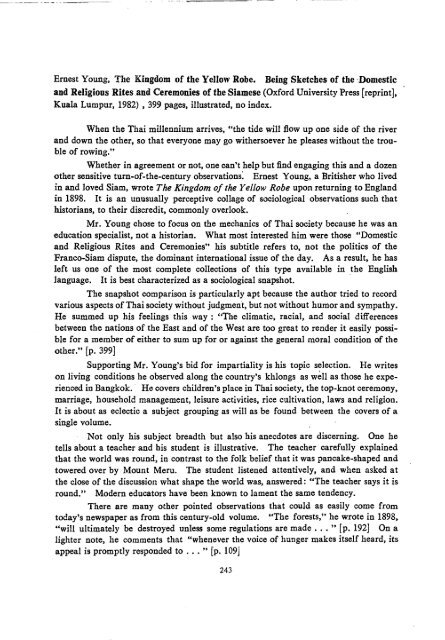The Journal of the Siam Society Vol. LXXII, Part 1-2, 1984 - Khamkoo
The Journal of the Siam Society Vol. LXXII, Part 1-2, 1984 - Khamkoo
The Journal of the Siam Society Vol. LXXII, Part 1-2, 1984 - Khamkoo
Create successful ePaper yourself
Turn your PDF publications into a flip-book with our unique Google optimized e-Paper software.
Ernest Young, <strong>The</strong> Kingdom <strong>of</strong> <strong>the</strong> Yellow Robe. Being Sketches <strong>of</strong> <strong>the</strong> ·Domestic<br />
and Religious Rites .and Ceremonies <strong>of</strong> <strong>the</strong> <strong>Siam</strong>ese (Oxford University Press [reprint],<br />
Kuala Lumpur, 1982) , 399 pages, illustrated, no index.<br />
When <strong>the</strong> Thai millennium arrives, "<strong>the</strong> tide will flow up one side <strong>of</strong> <strong>the</strong> river<br />
and down <strong>the</strong> o<strong>the</strong>r, so that everyone may go wi<strong>the</strong>rsoever he pleases without <strong>the</strong> trouble<br />
<strong>of</strong> rowing."<br />
Whe<strong>the</strong>r in agreement or not, one can't help but find engaging this and a dozen<br />
o<strong>the</strong>r sensitive tum-<strong>of</strong>-<strong>the</strong>-century observations: Ernest Young, a Britisher who lived<br />
in and loved <strong>Siam</strong>, wrote <strong>The</strong> Kingdom <strong>of</strong> <strong>the</strong> Yellow Robe upon returning to England<br />
in 1898. It is an unusually perceptive collage <strong>of</strong> sociological observations such that<br />
historians, to <strong>the</strong>ir discredit, commonly overlook.<br />
Mr. Young chose to focus on <strong>the</strong> mechanics <strong>of</strong> Thai society because he was an<br />
education specialist, not a historian. What most interested him were those "Domestic<br />
and Religious Rites and Ceremonies" his subtitle refers to, not <strong>the</strong> politics <strong>of</strong> <strong>the</strong><br />
Franco-<strong>Siam</strong> dispute, <strong>the</strong> dominant international issue <strong>of</strong> <strong>the</strong> day. As a result, he has<br />
left us one <strong>of</strong> <strong>the</strong> most complete collections <strong>of</strong> this type available in <strong>the</strong> English<br />
language. It is best characterized as a sociological snapshot.<br />
<strong>The</strong> snapshot comparison is particularly apt because <strong>the</strong> author tried to record<br />
various aspects <strong>of</strong> Thai society without judgment, but not without humor and sympathy.<br />
He summed up his feelings this way : "<strong>The</strong> climatic, racial, and social differences<br />
between <strong>the</strong> nations <strong>of</strong> <strong>the</strong> East and <strong>of</strong> <strong>the</strong> West are too great to render it easily possible<br />
for a member <strong>of</strong> ei<strong>the</strong>r to sum up for or against <strong>the</strong> general moral condition <strong>of</strong> <strong>the</strong><br />
o<strong>the</strong>r." (p. 399]<br />
Supporting Mr. Young's bid for impartiality is his topic selection. He writes<br />
on living conditions he observed along <strong>the</strong> country's khlongs as w~ll as those he experienced<br />
in Bangkok. He covers children's place in Thai society, <strong>the</strong> top-knot ceremony,<br />
marriage, household management, leisure activities, rice cultivation, laws and religion.<br />
It is about as eclectic a subject grouping as will as be found between <strong>the</strong> covers <strong>of</strong> a<br />
single volume.<br />
Not only his subject breadth but also his anecdotes are discerning. One he<br />
tells about a teacher and his student is illustrative. <strong>The</strong> teacher carefully explained<br />
that <strong>the</strong> world was round, in contrast to <strong>the</strong> folk belief that it was pancake-shaped and<br />
towered over by Mount Meru. <strong>The</strong> student listened attentively, and when asked at<br />
<strong>the</strong> close <strong>of</strong> <strong>the</strong> discussion what shape <strong>the</strong> world was, answered: "<strong>The</strong> teacher says it is<br />
round." Modem educators have been known to lament <strong>the</strong> same tendency.<br />
<strong>The</strong>re are many o<strong>the</strong>r pointed observations that could as easily come from<br />
today's newspaper as from this century-old volume. "<strong>The</strong> forests," he wrote in 1898,<br />
"will ultimately be destroyed unless some regulations are made ..• " [p. 192] On a<br />
lighter note, he comments that "whenever <strong>the</strong> voice <strong>of</strong> hunger makes itself beard, its<br />
appeal is promptly responded to ... " [p. 109]<br />
243

















